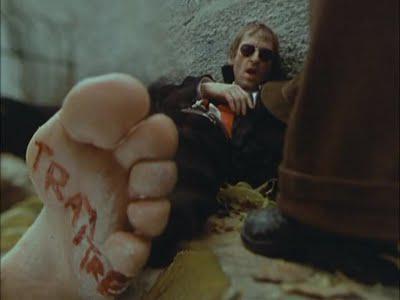
The titular crowns are Dutch coins requested as payment by a drunken sailor to help out a student who killed his friend and benefactor. He also demands the lad listen to his story, something the obviously impatient boy does not have time for but agrees to in desperation. What follows is a tale that soon reveals itself to be less a recollection than an amalgamation of sailors' myths and the folklore of various cultures with port cities. Black and white reality fades into lush, overlit color as the sailor reminisces, the blinding effect of the glossy look visually suggesting the falsity of the remembrances well before the stories splinter off into abandon. The sailor recounts feeling constrained in the Chilean port city of Valparaiso, and when a blind captain offers him a place aboard his ship before being murdered, the sailor takes his chance to desert the parents he resents and the wife who knows her beauty will torment him rather than delight him as he grows old in his cage. But once he sets sail, he slowly comes to realize that all of the other crew members are dead.
Set thus on a drifting ghost ship where the crew relates stories to the sole living shipmate, Three Crowns of the Sailor is narratively unmoored, floating around nondescript seas and docking just long enough to expose the sailor to yet more stories from strangers who carry around folk tales and oddities like long-forgotten gods clung to by one last follower not out of belief but habit. This is a vision of an immortal story, each strand itself filtered and altered in its passing down and then warped and bent to fit into the sailor's own narrative. As the living man on a ghost ship, he must carry the burden of the dead's memories, and soon whatever story he had to tell has spiraled beyond all comprehension.
That is not to say that the film's vignettes are without meaning, however. In Singapore, the sailor comes across a young child who can speak neither Spanish nor French. Out of nowhere, a French proconsul walks up and informs the sailor that the boy is actually an old doctor of at least 90 years of age. The consul says that the boy stays young if he doesn't eat, and he brags of and bemoans the stress and cost of denying the boy food so he will not age. It's a surreal aside, but also one that clearly satirizes the paternalistic colonialism of European powers. Another child, who saves the sailor from an attack, tells the that his parents gave him free roam of their domain, but the child's inability to fathom or process the boundaries of that territory keep him fearfully locked inside the family home, made a prisoner by his fear of freedom.
As shot by Sacha Vierny, the color and especially the black and white scenes recall the legendary cinematographer's work on Alain Resnais' Last Year at Marienbad. The eerie, mathematical precision of his anti-gravity lateral tracks is as surreal as the actual mise-en-scène, which is suitably off-the-wall. The black-and-white scenes (and some color ones) at least indirectly quote numerous Orson Welles movies, from the artistically skewed imagery of The Lady from Shanghai and The Trial to a close-up of mumbling lips in bed that recalls the famed "Rosebud" utterance of Citizen Kane. Other sights are just plain surreal on Ruiz's terms, from the dead shipmates oozing worms out of their pores instead of sweating to an exotic dancer who reveals herself to be "completely naked" to the sailor when she not only removes her clothes but her nipples and vagina, leaving only one orifice (a comment on strippers being all talk, perhaps?).
Despite all odds, Three Crowns of the Sailor manages to resolve its plot in a satisfactory fashion, but even that is a clear means of merely keeping the story going and ensuring its neverending narrative does not halt. Some quick flutters between monochrome and color near the end show "reality" bleeding into the patched together quilt of folktales, ghost stories and oral histories, a more overt blend than earlier match cuts between actions to link "fiction" and "the real world." The characters, like Ruiz, know they're in a story and work toward establishing their own tales within the larger collection of accounts, and if even the coherently resolved plot still makes no sense, this structure makes inescapably clear that the journey does not lead to the story but is the story. Its ingenious visual splendor is but the way the rhapsode sings this epic.

